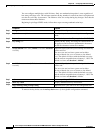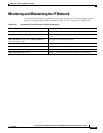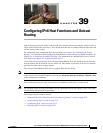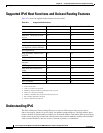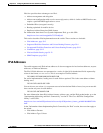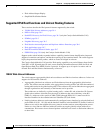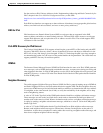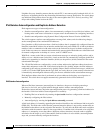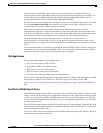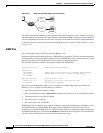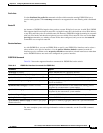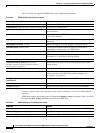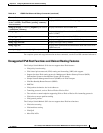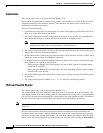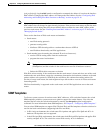
39-6
Cisco Catalyst Switch Module 3110 and 3012 for IBM BladeCenter Software Configuration Guide
OL-12189-01
Chapter 39 Configuring IPv6 Host Functions and Unicast Routing
Understanding IPv6
Neighbor discovery throttling ensures that the switch CPU is not unnecessarily burdened while it is in
the process of obtaining the next-hop forwarding information to route an IPv6 packet. The switch drops
any additional IPv6 packets whose next hop is the same neighbor the CPU is actively resolving. This
drop avoids adding further load on the CPU.
IPv6 Stateless Autoconfiguration and Duplicate Address Detection
IPv6 supports two types of autoconfiguration:
• Stateless autoconfiguration, where a host autonomously configures its own link-local address, and
booting nodes send router solicitations to request router advertisements for configuring interfaces.
• Stateful autoconfiguration using Dynamic Host Configuration Protocol Version 6 (DHCPv6).
The switch supports stateless autoconfiguration to manage link, subnet, and site addressing changes,
such as management of host and mobile IP addresses.
Every interface on IPv6 nodes must have a link-local address that is automatically configured from the
identifier (router MAC address) for an interface and the link-local prefix FE80::/10. A link-local address
enables a node to communicate with other nodes on the link and can be used to further configure the
node. Nodes can connect to a network and automatically generate global IPv6 addresses without the need
for manual configuration or the help of a server, such as a DHCP server.
With IPv6, a router on the link uses router advertisement messages to advertise global prefixes and its
ability to act as a default router for the link. A node on the link can automatically configure global IPv6
addresses by appending its interface identifier (64 bits) to the prefixes (64 bits) included in the router
advertisement messages.
The 128-bit IPv6 addresses configured by a node are then subjected to duplicate-address detection to
ensure their uniqueness on the link. If the advertised prefixes are globally unique, the IPv6 addresses
configured by the node are guaranteed to be globally unique. Router solicitation messages, which have
a value of 133 in the ICMP packet header Type field, are sent by hosts at system startup so that the host
is immediately autoconfigured without waiting for the next scheduled router advertisement message.
IPv6 duplicate-address detection is performed on unicast addresses before they are assigned to an
interface. The switch does not support automatically generated site-local IPv6 addresses.
IPv6 Stateless Autoconfiguration
When an IPv6 host (nonrouter) autoconfigures its interfaces, the process includes generating a
link-local, a site-local, and a global address through stateless address autoconfiguration.
IPv6 nodes (routers and hosts) begin the autoconfiguration process by generating a link-local address for
the interface. Link-local address autoconfiguration is started by:
• Enabling IPv6 on an interface by entering the ipv6 enable interface configuration command
• Manually configuring the IPv6 address
• Autoconfiguring by entering the ipv6 address autoconfig command
A link-local address is formed by appending the interface identifier to the well-known link-local prefix
(FE80::/10). The IPv6 node verifies that the generated tentative address is not used by another node on
the link before the address can be assigned to the interface. To verify this, the IPv6 node sends a neighbor
solicitation with the tentative address as the target address. If another node is detected to be using that
address or is attempting to use that address (duplicate address detection), the node sends a neighbor
solicitation for the target as well. If the tentative link-local address is not available, autoconfiguration
stops and you must manually configure the interface.



